Maine, known for its rugged landscapes and incredible coastline wilderness, is home to a diverse range of bird species. Among its feathered residents, woodpeckers stand out as intriguing and industrious birds. Of the 23 native species of woodpeckers in the United States, nine have adapted to various ecosystems within the state of Maine. This article will focus on those nine species, how to identify them, where to find them, and more. Shedding further light on their preferred habitats, nesting habits, foraging grounds, and the optimal time to catch a glimpse of these charming birds.
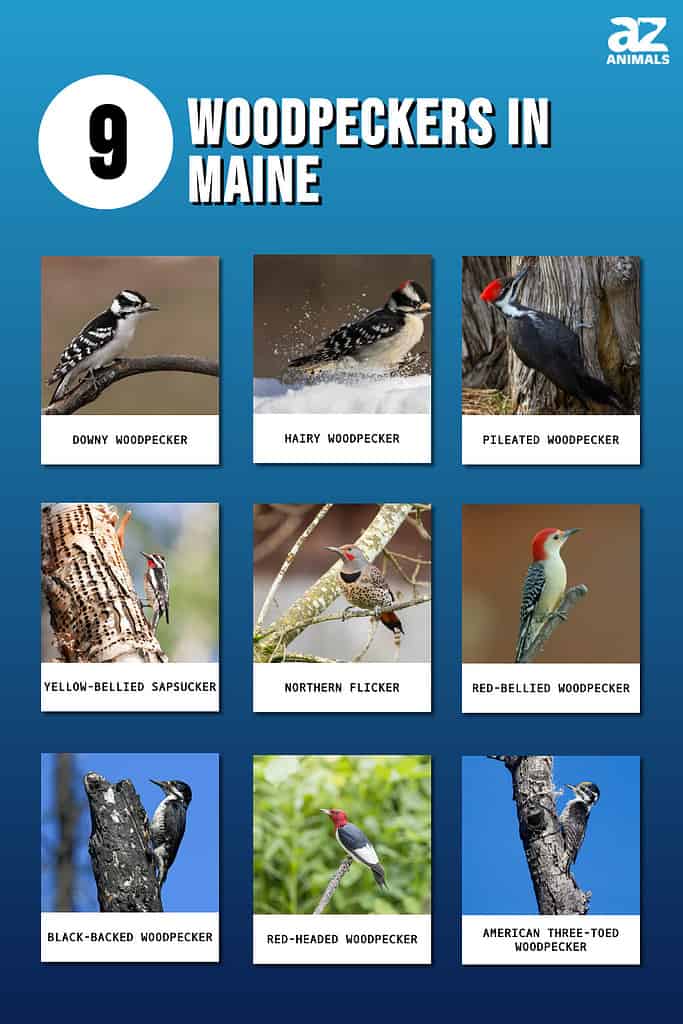
Where to Find Woodpeckers in Maine
Maine is home to nine woodpecker species, each possessing its distinctive characteristics and preferences. Before diving into each specific species, let’s first look at how to find woodpeckers in Maine.
Preferred Habitats of Woodpeckers in Maine
Woodpeckers in Maine inhabit a variety of landscapes, displaying remarkable adaptability to their surroundings. These resourceful birds can be found in forests, woodlands, parks, and even suburban areas. However, they exhibit a strong affinity for mature deciduous and mixed forests, where they can find an abundance of trees with suitable nesting and foraging opportunities.
The presence of dead or decaying trees that are still standing often referred to as “snags,” is of particular importance to woodpeckers. Snags serve as both nesting sites and foraging grounds, as they are rich in insects and provide excellent support for cavity excavation. The diversity of tree species in Maine’s forests, including oaks, pines, maples, and beeches, offers a smorgasbord of insect life that woodpeckers relish.
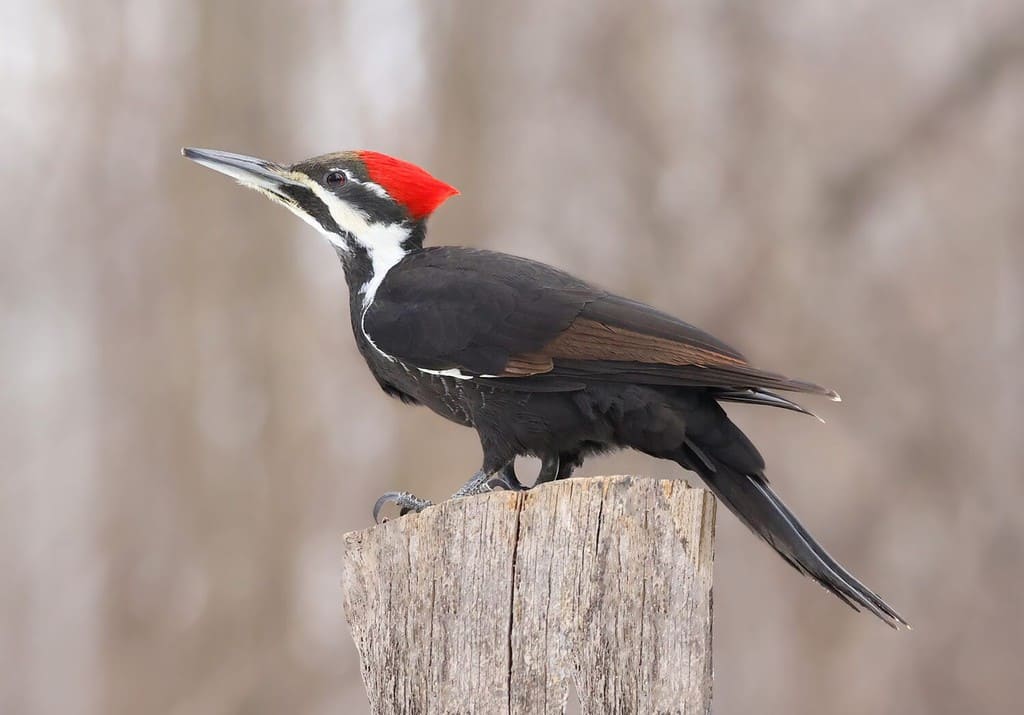
Pileated Woodpeckers are some of the most commonly seen species of woodpeckers in Maine.
©Vlad G/Shutterstock.com
Notable Locations for Viewing Woodpeckers in Maine
If you’re keen on observing woodpeckers in their natural habitat, several locations in Maine offer excellent opportunities. Baxter State Park, renowned for its wilderness and diverse birdlife, is a prime spot for woodpecker enthusiasts. The expansive forests of the White Mountains in western Maine and parts of the Appalachian Trail that cross through the state provide promising chances to spot these birds. Moreover, parks such as Acadia National Park and Bradbury Mountain State Park are also known for their woodpecker populations.
When exploring these areas, keep your eyes peeled for the distinct markings and behaviors of the various species of Woodpeckers residing in Maine. They are often seen drumming on tree trunks, flying between branches on middle heights of trees, or foraging for insects.
Nesting Habits of Woodpeckers in Maine
Woodpeckers in Maine employ a unique strategy when it comes to nesting. They excavate cavities in trees, often snags, to create safe and secure roosting shelters or nesting shelters for their offspring. These cavities not only protect from predators but also serve as cozy homes to rest.
Each woodpecker species may have specific preferences when choosing a nesting site. For instance, Pileated Woodpeckers, Downy Woodpeckers, and Hairy Woodpeckers create separate cavities for nesting and roosting. Furthermore, a pair of Pileated Woodpeckers may often use the same nesting cavity for about a year. Meanwhile, single Phileated Woodpeckers may create and use upwards of 12 roosting cavities every year.
Foraging Behaviors of Woodpeckers in Maine
Woodpeckers are renowned for their drumming and pecking on trees. This behavior is associated with finding food, finding a mate, establishing territory, and excavating cavities. In the food search, their rhythmic strikes serve to dislodge and unearth insects hiding beneath the bark.
Best Time of Day to See Woodpeckers in Maine
The timing of woodpecker sightings in Maine largely depends on their feeding habits. Woodpeckers are diurnal birds, meaning they are most active during daylight hours. To maximize your chances of observing these birds, venture into the woods in the early morning or late afternoon when they are actively foraging for insects.
Here is a quick recap of elements to help you find woodpeckers in Maine. These birds are an integral part of the state’s rich avian biodiversity. You can find them in a variety of habitats, with mature deciduous and mixed forests being their preferred residence. Notable locations for woodpecker viewing include the various state parks, national parks, and areas with plenty of woodlands. These birds employ unique nesting habits, excavating tree cavities for shelter and reproduction. To catch a glimpse of woodpeckers in action, visit their foraging grounds during the early morning or late afternoon.

The lush landscapes of Maine are home to around nine species of woodpeckers.
©Alexey Stiop/Shutterstock.com
9 Woodpeckers Found in Maine
1. Downy Woodpecker (Dryobates pubescens)
First on our list of woodpeckers found in Maine is the Downy woodpecker. The Downy woodpecker is a small, striking bird found throughout Maine’s woodlands. This species is between the size of a sparrow and a robin. Their average length is approximately 5.5 to 6.7 inches (14 to 17 centimeters). They weigh around 0.7 to 1.0 ounces (21 to 28 grams). Furthermore, their wingspan is roughly 9.8 to 11.8 inches (25 to 30 centimeters). According to the National Audubon Society, this species distinguishing features include bodies that are checkered black and white. Their heads have horizontal stripes, and their backs have one white stripe down the center. You can identify males by a small red patch on the back of their head, which is absent in females. They emit a sharp, high-pitched “pik” call and a distinctive whinnying sound.
Downy woodpeckers primarily feed on insects and larvae found beneath tree bark, as well as seeds from various plants. Their strong beaks are excellent tools for foraging in this manner. They also feed on ants, caterpillars, corn earworms, tent caterpillars, bark beetles, and apple borers. Furthermore, a portion of their diet also consists of plant material such as berries, acorns, and grains. Lastly, they can commonly visit bird feeders, feeding on suet and black oil sunflower seeds and sometimes even drinking from hummingbird feeders.

The scientific name of the Downy woodpecker is
Dryobates pubescens.
©Jim Nelson/Shutterstock.com
2. Hairy Woodpecker (Dryobates villosus)
The Hairy woodpecker closely resembles the Downy woodpecker but is slightly larger. They are approximately the size of a robin. Their lengths reach 7.1 to 10.2 inches (18 to 26 centimeters). They tend to weigh between 1.4 to 3.4 ounces (40 to 95 grams). Moreover, their wingspan is approximately 13.0 to 16.1 inches (33 to 41 centimeters). They sport a black and white plumage with a stark white belly, checkered patterns on the wings, and a white stripe down its black back. The male also possesses a small red patch on the back of its head, distinguishing it from the female. Their call is a sharp “peek” sound, similar to Downy woodpeckers, but with a marginally lower, more emphatic pitch.
Hairy woodpeckers have a diet similar to Downy woodpeckers, focusing on insects and larvae, supplemented by seeds and fruits. They visit bird feeders and feed bees, spiders, wasps, caterpillars, millipedes, and, on rare occasions, cockroaches, grasshoppers, and crickets.

The scientific name of the Hairy Woodpecker is
Dryobates villosus.
©sandymsj/Shutterstock.com
3. Pileated Woodpecker (Dryocopus pileatus)
Third on our list of woodpeckers found in Maine is the Pileated woodpecker. The Pileated woodpecker is one of Maine’s most distinctive woodpecker species. They are a larger species, similar to the size of a crow. They grow to lengths of 15.8 to 19.3 inches (40 to 49 centimeters). Their weights range from 8.8 to 12.3 ounces (250 to 350 grams), and their wingspans tend to be 26.0 to 29.5 inches (66 to 75 centimeters). While it is notable for its large size, it is also well-known for its markings. Pileated Woodpeckers have primarily black bodies with white stripes on their faces and necks. Both males and females have a vivid red crest. Moreover, males have a red stripe on their cheeks. Lastly, they also have white underwings. They are quite vocal, with higher-pitched piping calls. In addition, their calls can include a series of loud, piercing “cuk-cuk” or “wuk-wuk” sounds.
These woodpeckers are experts at excavating large tree cavities and feed mainly on carpenter ants and beetle larvae found in decaying trees. They also feed on other ants, termites, woodboring beetle larvae, flies, spruce budworms, cockroaches, caterpillars, and grasshoppers. Furthermore, a small portion of their diets consists of various fruits and seeds such as dogwood, persimmon, sassafrass, greenbrier, hackberry, blackberries, sumac berries, poison ivy, holly, and elderberry.

The scientific name of the Pileated woodpecker is
Dryocopus pileatus.
©FotoRequest/Shutterstock.com
4. Yellow-bellied Sapsucker (Sphyrapicus varius)
The Yellow-bellied Sapsucker is a woodpecker with distinctive plumage. They are also about the size of a robin, with lengths measuring 7.1 to 8.7 inches (18 to 22 centimeters). They weigh around 1.5 to 1.9 ounces (43 to 55 grams). Lastly, their wingspan is between 13.4 to 15.8 in (34 to 40 centimeters) on average. These woodpeckers are predominantly black and white, with white or yellowish underparts. Their faces are patterned with stripes, and their bodies are checkered. Males and females have red foreheads, while males additionally have red throats.
As their name suggests, Yellow-bellied Sapsuckers primarily feed on tree sap. They drill rows of small holes in tree bark to access sap, and insects attracted to it. They also consume fruits and insects.

The scientific name of the Yellow-bellied Sapsucker is
Sphyrapicus varius.
©Dennis W. Donohue /Shutterstock.com
5. Northern Flicker (Colaptes auratus)
Fifth on our list of woodpeckers found in Maine is the Northern Flicker. The Northern Flicker is a unique woodpecker species with a more ground-dwelling lifestyle. Its size is between that of a robin and a crow. They grow to lengths of 11.0 to 12.2 inches (28 to 31 centimeters), weigh between 3.9 to 5.6 ounces (110 to 160 grams), and have a wingspan between 16.5 to 20.1 inches (42 to 51 centimeters). They have a brownish-gray back, a white rump visible when perched, yellow undersides, and tail feathers. Moreover, the brown plumage has black spots, bars, and crescents patterned across it. Their call is a distinctive “wick-a-wick-a-wick” sound, often heard during flight. They also have a loud single-note “kyeer” call. Moreover, they make loud rolling rattles lasting more than 7 seconds long.
Northern Flickers primarily feed on ants and beetles, which they find on the ground by probing the soil with their long, pointed beaks. They also consume fruits and seeds. Other aspects of their diet include flies, moths, butterflies, snails, poison oak, poison ivy, sumac, dogwood, wild cherry, wild grape, bayberries, hackberries, elderberries, sunflower seeds, and thistle seeds.
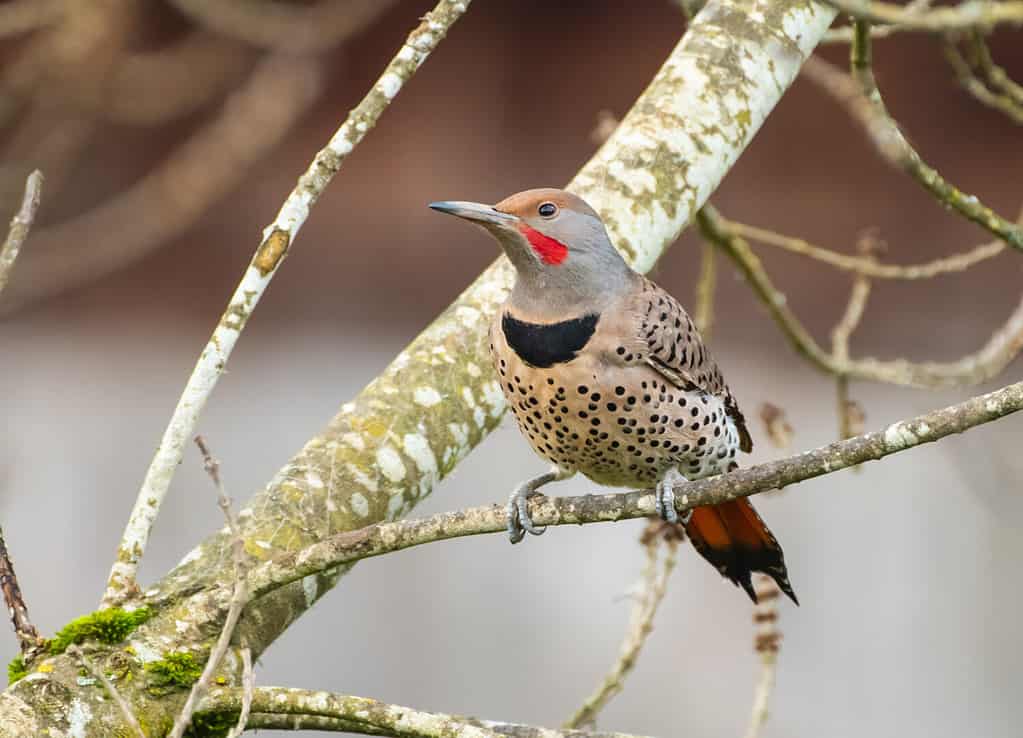
The scientific name of the Northern Flicker is
Colaptes auratus.
©Jennifer Bosvert/Shutterstock.com
6. Red-bellied Woodpecker (Melanerpes carolinus)
Despite its name, the Red-bellied woodpecker has only a faint blush of red on its belly, which is often not visible in the field. When it comes to size, they are between the size of a robin and a crow. They grow to lengths of about 9.4 inches (24 centimeters). Their weight ranges from 2.0 to 3.2 ounces (56 to 91 grams), while their wingspan ranges from 13.0 to 16.5 inches (33 to 42 centimeters). Overall, this species has a pale appearance, with a vividly striped back of black and white and a bright red cap and nape. Males can have slightly more colorful red markings than females. In addition, they have white patches near the tips of their wings. The call of the Red-bellied woodpecker is a distinctive shrill and rolling “kwirr” or “churr” call. They can also give off a gruff and coughing “cha cha cha” call.
These woodpeckers primarily feed on insects, including beetles and ants. They also feed on spiders and other arthropods. They tend to eat more plant material and fruit than other species, which include acorns, nuts, pine cones, seeds from annual and perennial plants, grapes, hackberries, and more. On occasion, they will also eat minnows, lizards, and nestling birds.
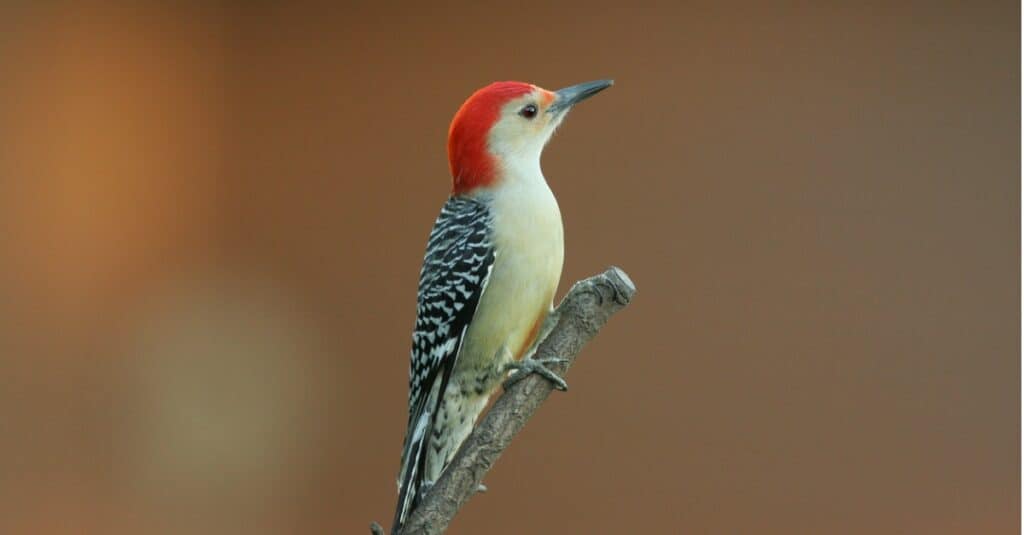
The scientific name of the Red-bellied woodpecker is
Melanerpes carolinus.
©iStock.com/Flatcoater
7. Black-backed Woodpecker (Picoides arcticus)
Next on our list of woodpeckers found in Maine is the Black-backed woodpecker. The Black-backed woodpecker is a distinctive species with an all-black back and a white belly. Also mirroring the size of a robin, they grow to lengths of about 9.1 inches (23 centimeters), weigh between 2.1 to 3.1 ounces (61 to 88 grams), and have a wingspan of approximately 15.8 to 16.5 inches (40 to 42 centimeters). This species is dark black above, with white below, and has lighter black barring along its flanks. Their heads are nearly entirely black. They have a single white malar stripe and small white marks behind their eyes. Males and juveniles have a small yellow patch on their foreheads, while females lack this feature. Their call is a series of sharp “pik” or “kyik” sounds. Moreover, they can express rattling-type snarls.
This woodpecker specializes in feeding on woodboring insects found in burned or decaying trees. Its preference for post-fire habitats makes it a unique species in Maine’s woodpecker community. They prefer to feed on large and small larvae and woodboring beetles.
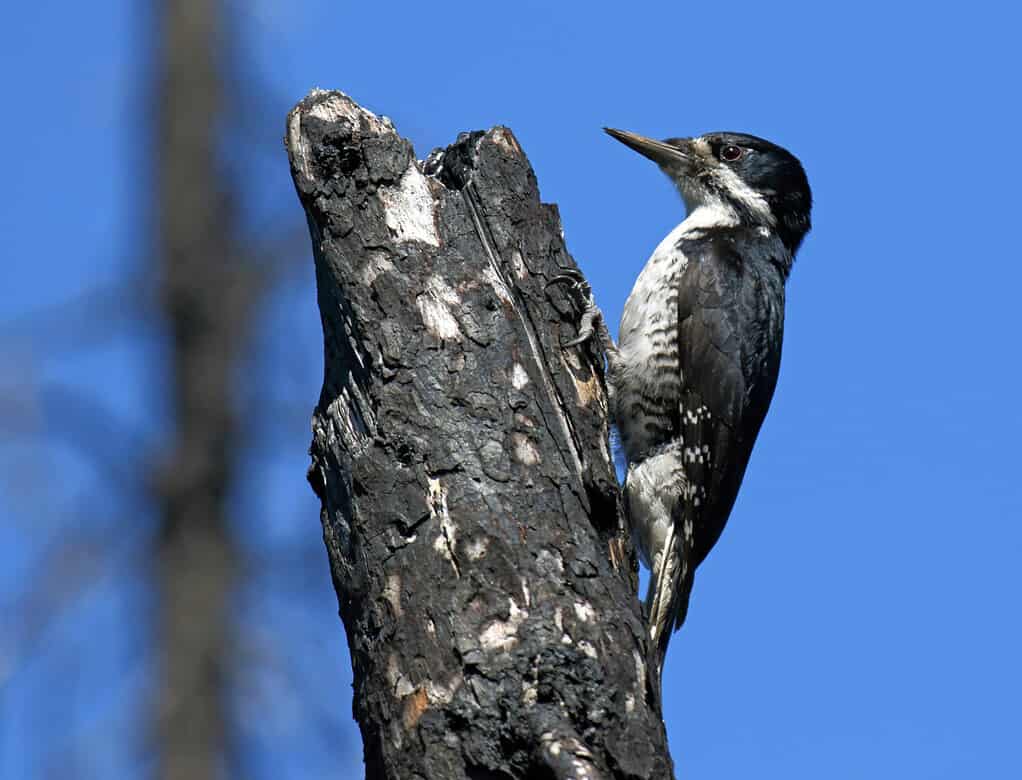
The scientific name of the Black-backed woodpecker is
Picoides arcticus.
©Agami Photo Agency/Shutterstock.com
8. Red-headed Woodpecker (Melanerpes erythrocephalus)
The Red-headed woodpecker is known for its striking plumage, featuring a vibrant red head, neck, and throat. They grow between the size of a robin and a crow. Their lengths can be between 7.5 to 9.1 inches (19 to 23 centimeters). They can weigh between 2.0 to 3.2 ounces (56 to 91 grams). Moreover, their wingspan can extend around 16.5 inches (42 centimeters). Aside from their striking redheads, this species has white underparts, dark black backs, and black wings with large white patches. Juveniles have gray-brown heads. They also have black spots near the edges of their white wing patches. Their most common call is a sharp “tchur-tchur” or “charr-charr” sound. They give off lots of chirps, cackles, and other sounds in general.
Red-headed woodpeckers have a varied diet, including insects, fruits, seeds, and even small vertebrates like frogs and mice. Other aspects of their diet include honeybees, beetles, cicadas, midges, grasshoppers, nuts, corn, acorns, beech nuts, pecans, berries, cherries, other fruits, bird eggs, other nestlings, mice, and occasionally adult birds.
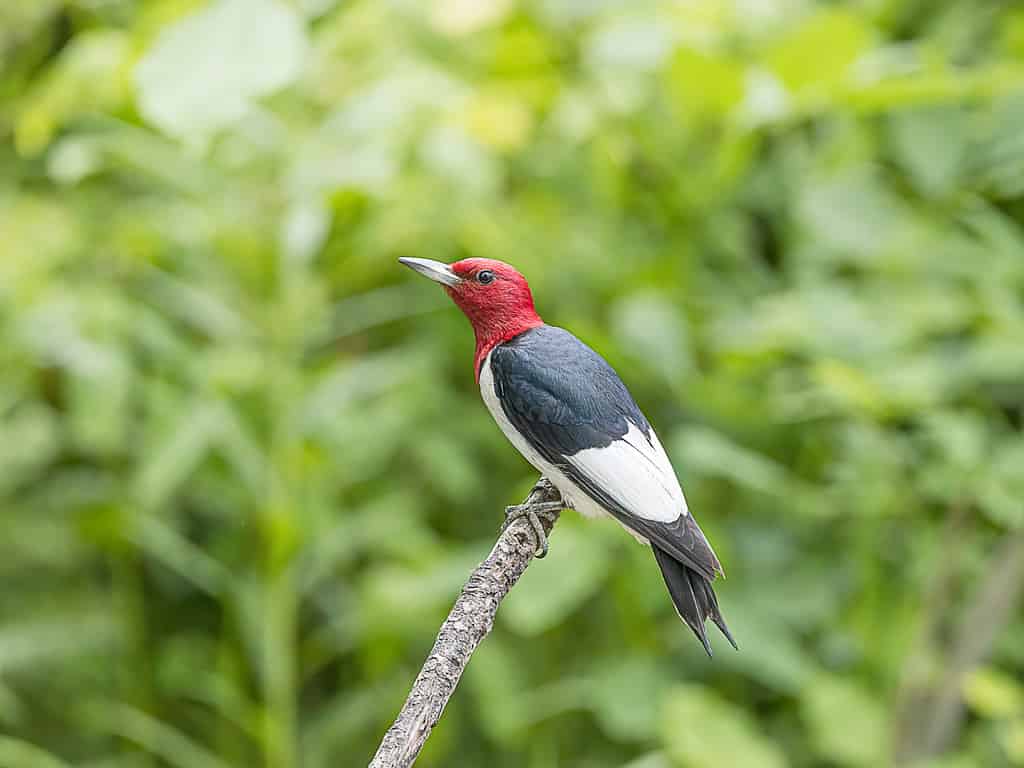
The scientific name of the Red-headed woodpecker is
Melanerpes erythrocephalus.
©ilkah/Shutterstock.com
9. American Three-toed Woodpecker (Picoides dorsalis)
Last on our list of woodpeckers found in Maine we have the American Three-toed Woodpecker. It is a small, inconspicuous woodpecker species that grows to lengths of 8.3 to 9.1 inches (21 to 23 centimeters). Their weight can range from 1.6 to 2.4 ounces (44.8 to 67.9 grams). Moreover, their wingspan can be between 14.6 to 15.3 inches (37 to 39 centimeters). This species has a black back accompanied by chaotic white barring. They also have white underparts with lighter black barring on their flanks, white spots on the wings, and a distinctive yellow crown patch on males and juveniles. They have black faces and a white line behind the eyes as well as below the cheeks. As the name suggests, these woodpeckers have only three toes on each foot, a unique feature among woodpeckers. Their calls consist of a soft, high-pitched “pik” sound and nasally “klimp” sound. They can also produce fussy rattling or twittering calls.
This species specializes in foraging for insects beneath tree bark, particularly in coniferous forests. They also consume sap from trees, similar to the Yellow-bellied Sapsucker.

The American Three-toed woodpecker only has three toes, which is strange when compared to other woodpeckers, who usually have four toes.
©Jukka Jantunen/Shutterstock.com
5 Ways to Attract Woodpeckers
To attract woodpeckers to your yard, you can employ a combination of strategies that appeal to these birds’ specific needs and preferences. While the allure of these remarkable birds may initially be visual, attracting them involves providing food sources and being in a suitable habitat.
1. Providing Food Sources
Woodpeckers are primarily insectivorous, feasting on insects and larvae found beneath tree bark. By setting up suet feeders stocked with suet cakes containing insects or mealworms, you can offer a delectable buffet for these birds. Additionally, providing nut and seed feeders with nuts, sunflower seeds, or fruits can supplement their diet.
2. Food Placement
Position suet feeders strategically in your yard, ideally near mature trees, as woodpeckers are more likely to visit when they feel secure in familiar surroundings. Similarly, place seed feeders near trees or shrubs to provide cover. Also, select feeders such as vertical logs utilizing suet plugs, mesh tube feeders, suet cake feeders, hoppers, and trays.
3. Nesting Opportunities
To encourage woodpeckers to consider your yard for nesting, leave dead or decaying trees, known as snags, standing whenever possible. Snags provide suitable nesting sites. You can also install woodpecker nest boxes in your yard, mimicking their natural cavities.
4. Fresh Water Source
Like all birds, woodpeckers need a source of fresh water for drinking and bathing. Consider placing a birdbath or a shallow dish of water in your yard, keeping it clean and refreshed regularly.
5. Minimize Pesticide and Chemical Use
Woodpeckers are drawn to areas with abundant insects. Reducing or eliminating pesticide use in your yard can help attract them by promoting a healthy insect population while also minimizing their exposure to dangerous chemicals and pesticides.
By thoughtfully providing for their needs, you can create an inviting habitat for woodpeckers in your yard. These efforts not only offer a chance to witness these charismatic birds up close but also contribute to providing resources for them.
Summary of 9 Woodpeckers in Maine (Pictures, ID Guide, and Common Locations)
| Woodpecker | Scientific Name | Distinctive Traits | |
|---|---|---|---|
| 1 | Downy Woodpecker | Dryobates pubescens | black and white checks |
| 2 | Hairy Woodpecker | Dryobates villosus | black and white checkered wings, white belly, and stripe down back |
| 3 | Pileated Woodpecker | Dryocopus pileatus | black body with white stripes on face and red crest |
| 4 | Yellow-bellied Sapsucker | Sphyrapicus varius | black and white with white or yellow underparts |
| 5 | Northern Flicker | Colaptes auratus | black and white with stripes and a brown rump |
| 6 | Red-bellied Woodpecker | Melanerpes carolinus | pale body, blush breast, and a red head |
| 7 | Black-backed Woodpecker | Picoides arcticus | mostly black with white underbelly and some white markings on back |
| 8 | Red-headed Woodpecker | Melanerpes erythrocephalus | Striking red head with color blocked body of black and white |
| 9 | American Three-toed Woodpecker | Picoides dorsalis | black body with white specks and white lines behind eyes with 3 toes |
The photo featured at the top of this post is © Jim Nelson/Shutterstock.com
Thank you for reading! Have some feedback for us? Contact the AZ Animals editorial team.







